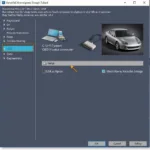The OBD2 port, often referred to as the vehicle’s “brain,” provides a wealth of diagnostic information for your Ford Ranger. Whether you’re a seasoned mechanic or a DIY enthusiast, knowing the location of this port and understanding its functions is crucial for troubleshooting and maintaining your truck’s performance. This guide provides everything you need to know about the Ford Ranger OBD2 port, its location, and its uses.
What is an OBD2 Port and Why is it Important?
The OBD2 port, short for On-Board Diagnostics, is a standardized 16-pin connector found in vehicles manufactured after 1996. It serves as the access point for retrieving diagnostic information from your Ford Ranger’s Engine Control Unit (ECU).
This port allows you to:
- Retrieve Diagnostic Trouble Codes (DTCs): Identify the root cause of warning lights on your dashboard, such as the check engine light.
- Monitor Real-time Engine Data: Access live sensor readings, including engine speed, coolant temperature, and oxygen sensor data.
- Assess Emission Readiness: Determine if your vehicle is ready for emissions testing.
- Customize Vehicle Settings (With Specific Tools): Some advanced scanners enable modifications to certain vehicle settings.
Where is the OBD2 Port Located on a Ford Ranger?
The OBD2 port on most Ford Ranger models is typically located under the dashboard on the driver’s side, near the steering column. It’s usually positioned above the footwell area and might be covered by a small plastic panel that can be easily removed.
However, the exact location may vary slightly depending on the model year of your Ranger.
Tips for Finding the OBD2 Port:
- Check Your Owner’s Manual: The owner’s manual of your Ford Ranger will usually provide a diagram or instructions on locating the OBD2 port.
- Look for a Trapezoidal Shape: The port has a distinctive trapezoidal shape with a 16-pin connector inside.
- Use a Flashlight: If you’re having trouble locating the port, using a flashlight to illuminate the area under the dashboard can be helpful.
Common Uses of the Ford Ranger OBD2 Port
The OBD2 port on your Ford Ranger is a powerful tool that can be used for a variety of purposes, including:
- DIY Diagnostics: Using an affordable OBD2 scanner, you can read and clear basic engine codes, providing insights into potential issues and saving you a trip to the mechanic.
- Professional Diagnostics and Repair: Mechanics utilize advanced scan tools to access in-depth diagnostic information, perform module programming, and troubleshoot complex engine problems.
- Performance Tuning (With Caution): Aftermarket performance tuners connect to the OBD2 port to adjust engine parameters and potentially enhance horsepower or fuel efficiency. However, it’s crucial to use reputable tuners and proceed with caution as improper tuning can damage your engine.
- Fleet Management: Companies with Ford Ranger fleets utilize OBD2 trackers for monitoring vehicle location, fuel consumption, driver behavior, and more.
Understanding OBD2 Trouble Codes
When your Ford Ranger encounters a problem, the ECU generates a specific Diagnostic Trouble Code (DTC) and stores it in its memory. These codes are standardized, meaning they follow a specific format that’s consistent across different vehicle makes and models.
Structure of an OBD2 Code:
- First Character: Indicates the system where the fault originated (e.g., “P” for Powertrain, “B” for Body, “C” for Chassis, “U” for Network Communication).
- Second Character: “0” represents a standardized code defined by the Society of Automotive Engineers (SAE), while “1” indicates a manufacturer-specific code.
- Third Character: Specifies the specific system or subsystem related to the fault (e.g., “1” for Fuel and Air Metering, “3” for Ignition System or Misfire).
- Fourth and Fifth Characters: Represent the specific fault within the system.
For example, the code “P0306” indicates a Powertrain (P) code defined by the SAE (0), related to the Ignition System or Misfire (3), and specifically points to a Cylinder 6 Misfire (06).
Using OBD2 Codes for Troubleshooting:
- Don’t Panic: A single trouble code doesn’t always indicate a major problem. Sometimes, it might be a minor issue like a loose gas cap.
- Note Down the Codes: Before clearing any codes, make sure to write them down or take a picture.
- Research the Codes: Numerous online resources and forums can help you decipher the meaning of specific OBD2 codes for your Ford Ranger.
- Consult a Professional: If you’re unsure about the meaning of a code or how to address the underlying issue, it’s best to consult a qualified mechanic.
Conclusion
Knowing the location of your Ford Ranger’s OBD2 port and understanding its capabilities is essential for anyone who wants to take charge of their vehicle’s maintenance and diagnostics. Whether you’re troubleshooting a warning light, monitoring engine performance, or customizing settings, the OBD2 port is a valuable tool at your disposal.
Remember to always consult your owner’s manual, research codes thoroughly, and seek professional help when necessary to ensure safe and effective use of your Ford Ranger’s OBD2 port.


